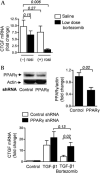Proteasomal inhibition after injury prevents fibrosis by modulating TGF-β(1) signalling
- PMID: 21921091
- PMCID: PMC3595535
- DOI: 10.1136/thoraxjnl-2011-200717
Proteasomal inhibition after injury prevents fibrosis by modulating TGF-β(1) signalling
Abstract
Background: The development of organ fibrosis after injury requires activation of transforming growth factor β(1) which regulates the transcription of profibrotic genes. The systemic administration of a proteasomal inhibitor has been reported to prevent the development of fibrosis in the liver, kidney and bone marrow. It is hypothesised that proteasomal inhibition would prevent lung and skin fibrosis after injury by inhibiting TGF-β(1)-mediated transcription.
Methods: Bortezomib, a small molecule proteasome inhibitor in widespread clinical use, was administered to mice beginning 7 days after the intratracheal or intradermal administration of bleomycin and lung and skin fibrosis was measured after 21 or 40 days, respectively. To examine the mechanism of this protection, bortezomib was administered to primary normal lung fibroblasts and primary lung and skin fibroblasts obtained from patients with idiopathic pulmonary fibrosis and scleroderma, respectively.
Results: Bortezomib promoted normal repair and prevented lung and skin fibrosis when administered beginning 7 days after the initiation of bleomycin. In primary human lung fibroblasts from normal individuals and patients with idiopathic pulmonary fibrosis and in skin fibroblasts from a patient with scleroderma, bortezomib inhibited TGF-β(1)-mediated target gene expression by inhibiting transcription induced by activated Smads. An increase in the abundance and activity of the nuclear hormone receptor PPARγ, a repressor of Smad-mediated transcription, contributed to this response.
Conclusions: Proteasomal inhibition prevents lung and skin fibrosis after injury in part by increasing the abundance and activity of PPARγ. Proteasomal inhibition may offer a novel therapeutic alternative in patients with dysregulated tissue repair and fibrosis.
Figures







Similar articles
-
In vivo investigations on anti-fibrotic potential of proteasome inhibition in lung and skin fibrosis.Am J Respir Cell Mol Biol. 2008 Oct;39(4):458-65. doi: 10.1165/rcmb.2007-0320OC. Epub 2008 May 5. Am J Respir Cell Mol Biol. 2008. PMID: 18458239
-
A synthetic PPAR-γ agonist triterpenoid ameliorates experimental fibrosis: PPAR-γ-independent suppression of fibrotic responses.Ann Rheum Dis. 2014 Feb;73(2):446-54. doi: 10.1136/annrheumdis-2012-202716. Epub 2013 Mar 20. Ann Rheum Dis. 2014. PMID: 23515440 Free PMC article.
-
Proteasome inhibition prevents development of experimental dermal fibrosis.Inflammation. 2012 Jun;35(3):810-7. doi: 10.1007/s10753-011-9380-y. Inflammation. 2012. PMID: 21882074
-
Proteasomal regulation of pulmonary fibrosis.Proc Am Thorac Soc. 2010 Feb;7(1):77-83. doi: 10.1513/pats.200906-055JS. Proc Am Thorac Soc. 2010. PMID: 20160152 Free PMC article. Review.
-
Angiotensin-TGF-beta 1 crosstalk in human idiopathic pulmonary fibrosis: autocrine mechanisms in myofibroblasts and macrophages.Curr Pharm Des. 2007;13(12):1247-56. doi: 10.2174/138161207780618885. Curr Pharm Des. 2007. PMID: 17504233 Review.
Cited by
-
Toll-like Receptor 9 Signaling Is Augmented in Systemic Sclerosis and Elicits Transforming Growth Factor β-Dependent Fibroblast Activation.Arthritis Rheumatol. 2016 Aug;68(8):1989-2002. doi: 10.1002/art.39655. Arthritis Rheumatol. 2016. PMID: 26946325 Free PMC article.
-
Validation of the 2nd Generation Proteasome Inhibitor Oprozomib for Local Therapy of Pulmonary Fibrosis.PLoS One. 2015 Sep 4;10(9):e0136188. doi: 10.1371/journal.pone.0136188. eCollection 2015. PLoS One. 2015. PMID: 26340365 Free PMC article.
-
The mighty fibroblast and its utility in scleroderma research.J Scleroderma Relat Disord. 2017 May-Aug;2(2):69-134. doi: 10.5301/jsrd.5000240. Epub 2017 May 19. J Scleroderma Relat Disord. 2017. PMID: 29270465 Free PMC article.
-
MicroRNA-21 in scleroderma fibrosis and its function in TGF-β-regulated fibrosis-related genes expression.J Clin Immunol. 2013 Aug;33(6):1100-9. doi: 10.1007/s10875-013-9896-z. Epub 2013 May 9. J Clin Immunol. 2013. PMID: 23657402
-
Mitochondrial DNA Sensing Pathogen Recognition Receptors in Systemic Sclerosis Associated Interstitial Lung Disease: A Review.Curr Treatm Opt Rheumatol. 2023 Dec;9(4):204-220. doi: 10.1007/s40674-023-00211-1. Epub 2023 Aug 8. Curr Treatm Opt Rheumatol. 2023. PMID: 38230363 Free PMC article.
References
-
- Derynck R, Zhang YE. Smad-dependent and Smad-independent pathways in TGF-beta family signalling. Nature. 2003;425:577–84. - PubMed
-
- Elliott PJ, Zollner TM, Boehncke WH. Proteasome inhibition: a new anti-inflammatory strategy. J Mol Med (Berl) 2003;81:235–45. - PubMed
-
- Richardson PG, Sonneveld P, Schuster MW, et al. Bortezomib or high-dose dexamethasone for relapsed multiple myeloma. N Engl J Med. 2005;352:2487–98. - PubMed
Publication types
MeSH terms
Substances
Grants and funding
LinkOut - more resources
Full Text Sources
Other Literature Sources
Medical
Miscellaneous
